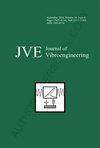Influence of wheel web structure on the tight-curve short-pitch corrugation of metro
IF 0.9
Q4 ENGINEERING, MECHANICAL
引用次数: 0
Abstract
Short-pitch corrugation is a common phenomenon that occurs on tight-curve rails in metro systems. However, the contributing factors of this problem are still not fully understood, and effective control measures have yet to be developed. In this study, we investigated the contributing factors of short-pitch corrugation on tight-curve rails in metro systems using the complex eigenvalue analysis method according to the theory of friction-induced vibration. We also explored control measures for short-pitch corrugation from the perspective of optimizing the wheel web structure. Our results indicate that friction-induced vibration is the primary contributing factor to short-pitch corrugation in the wheel-rail system. The shape of the web structure significantly affects rail corrugation, and compared to the straight web structure, unstable vibrations are more pronounced in the S-shape web structure. In contrast, the bow web structure can significantly improve the system stability of the wheel-rail interaction, and the greater the web curvature, the better the inhibitory effect. The wheel deformation under contact force varies with the web curvature, and when the axial deformation of the wheel extends toward the inner rail, the wheel-rail system no longer exhibits unstable vibrations. Conversely, when the axial deformation of the wheel extends toward the outer rail, the greater the deformation, the greater the instability of the wheel-rail system.轮腹板结构对地铁紧曲线短节距波纹的影响
短节距波纹是地铁窄曲线轨道的常见现象。然而,造成这一问题的因素仍未完全了解,有效的控制措施尚未制定。本文基于摩擦振动理论,采用复特征值分析方法,对地铁窄曲线轨道短节距波纹的影响因素进行了研究。并从优化轮腹板结构的角度探讨了短节距波纹的控制措施。结果表明,摩擦振动是轮轨系统产生短节距波纹的主要原因。腹板结构的形状对钢轨波纹有显著影响,与直腹板结构相比,s形腹板结构的不稳定振动更为明显。弓形腹板结构能显著改善轮轨相互作用的系统稳定性,且腹板曲率越大,抑制效果越好。车轮在接触力作用下的变形随腹板曲率的变化而变化,当车轮轴向变形向内轨方向延伸时,轮轨系统不再出现不稳定振动。反之,当车轮轴向变形向外轨延伸时,变形越大,轮轨系统的不稳定性越大。
本文章由计算机程序翻译,如有差异,请以英文原文为准。
求助全文
约1分钟内获得全文
求助全文
来源期刊

Journal of Vibroengineering
工程技术-工程:机械
CiteScore
1.70
自引率
0.00%
发文量
97
审稿时长
4.5 months
期刊介绍:
Journal of VIBROENGINEERING (JVE) ISSN 1392-8716 is a prestigious peer reviewed International Journal specializing in theoretical and practical aspects of Vibration Engineering. It is indexed in ESCI and other major databases. Published every 1.5 months (8 times yearly), the journal attracts attention from the International Engineering Community.
 求助内容:
求助内容: 应助结果提醒方式:
应助结果提醒方式:


